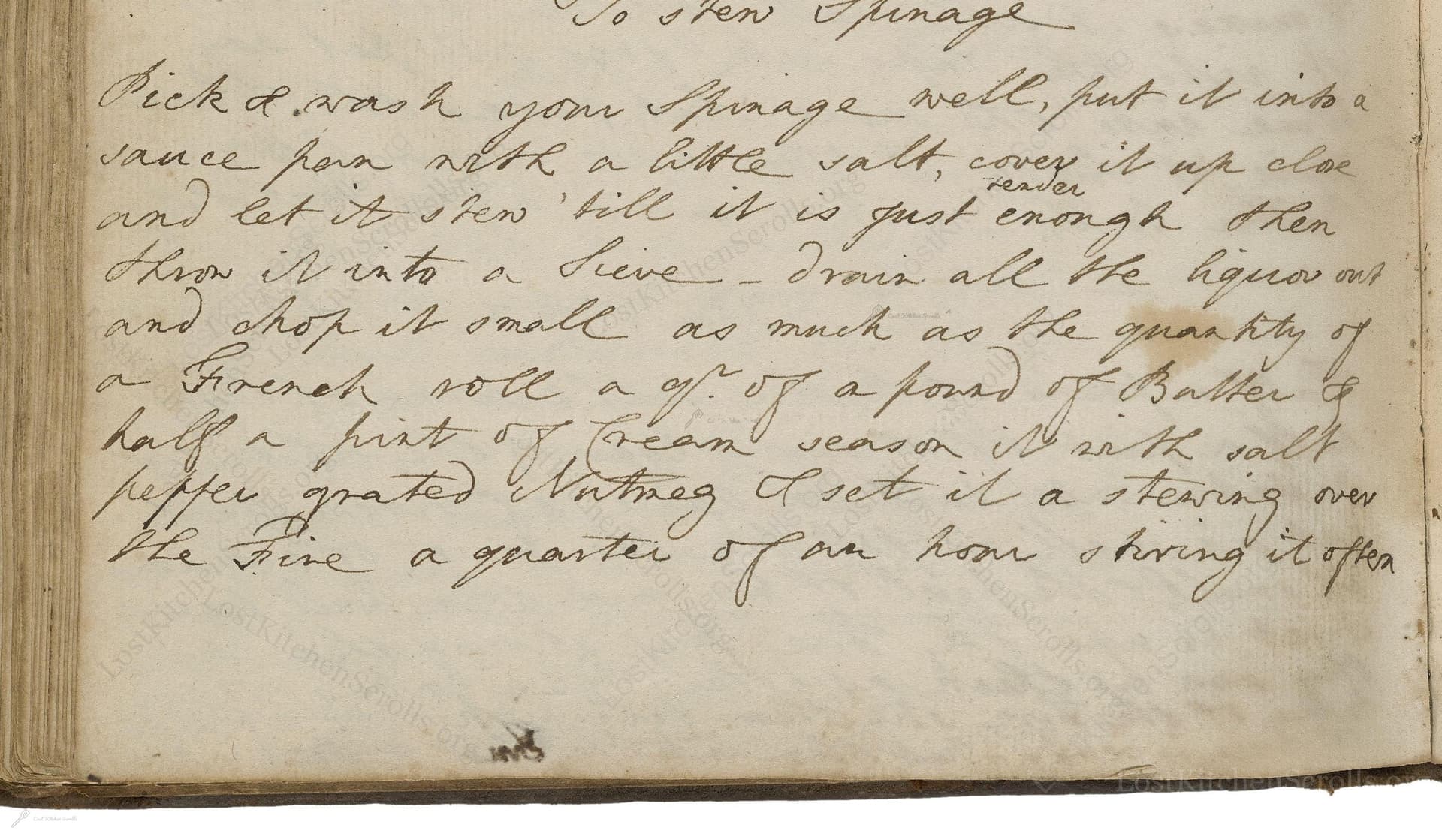
To Stew Spinage
"Pick & wash your Spinage well, put it into a sauce pan with a little salt, covey it up close and let it stew till it is just tender enough Then throw it into a Sieve - Drain all the liquor out and chop it small as much as the quantity of a french roll a quarter of a pound of Butter & half a pint of Cream season it with salt pepper grated Nutmeg & set it a stewing over the fire a quarter of an hour stirring it often"
Note on the Original Text
The original recipe is written in a flowing, conversational style, typical of 18th-century English cookbooks, which assumed a high level of kitchen knowledge. Measurements are imprecise, with references like 'the quantity of a French roll' and 'a quarter of a pound of butter,' requiring cooks to use intuition and experience. Spellings such as 'Spinage' for spinach, 'covey' for cover, and 'liquor' for liquid are all representative of the period's variable spelling conventions. The recipe makes no mention of specific cooking times or temperatures, a reflection of the era before standardized ovens and thermometers.

Title
Receipt book of Elizabeth Smith (1775)
You can also click the book image above to peruse the original tome
Writer
Elizabeth Smith
Era
1775
Publisher
Unknown
Background
Step into the refined kitchens of the late 18th century with Elizabeth Smith, whose culinary wisdom offers a charming taste of Georgian elegance and time-honored recipes to delight any palate.
Kindly made available by
Folger Shakespeare Library
This recipe hails from the kitchen of Elizabeth Smith, who was active between 1749 and 1800. During this era in Britain, vegetable cookery was becoming increasingly refined among the upper and middle classes. Spinach, once valued for its medicinal properties, started appearing as a delicate, creamy side dish—often paired with dairy and seasoned luxuriously. This dish would likely have adorned the table during a multi-course meal, reflecting the 18th-century fondness for rich sauces and French-influenced preparations. The use of butter and cream was a clear mark of status and culinary fashion of the time.

In the 18th century kitchen, the cook would have used a large iron or copper saucepan, a wooden spoon for stirring, and perhaps a metal or linen sieve to drain and press the spinach. Chopping would be done with a sturdy kitchen knife—weapons of choice in the age before food processors! The kitchen would likely have had an open hearth or a range with coal or wood fire, and the cook would balance the saucepan over the simmering heat, stirring constantly to achieve the dish's creamy texture.
Prep Time
10 mins
Cook Time
20 mins
Servings
4
We've done our best to adapt this historical recipe for modern kitchens, but some details may still need refinement. We warmly welcome feedback from fellow cooks and culinary historians — your insights support the entire community!
Ingredients
- 1 lb fresh spinach
- Pinch of salt (plus more to taste)
- 1 oz unsalted butter (up to 4 oz for a richer dish)
- 1 cup double cream
- Ground black pepper, to taste
- Freshly grated nutmeg, to taste
Instructions
- Begin by thoroughly washing about 1 pound of fresh spinach.
- Place it in a large saucepan with a pinch of salt, cover, and allow it to steam gently over medium heat until it is just tender, about 4-5 minutes.
- Drain the spinach in a sieve or colander, pressing out as much liquid as possible.
- Chop the drained spinach finely.
- Return the chopped spinach to a clean saucepan.
- Add approximately 1 ounce of unsalted butter (the historical 'a quarter of a pound' equates to about 4 ounces, but use less for modern tastes), and pour in about 1 cup (half a pint) of double cream.
- Season the mixture with salt, black pepper, and a generous grating of nutmeg to taste.
- Simmer the spinach mixture over gentle heat for about 15 minutes, stirring often to prevent sticking, until it becomes rich and creamy.
Estimated Calories
197 per serving
Cooking Estimates
Washing, chopping, and draining the spinach takes a bit of time, and then you need to cook everything gently on the stove. Each serving is rich and creamy and contains about 197 calories.
As noted above, we have made our best effort to translate and adapt this historical recipe for modern kitchens, taking into account ingredients nowadays, cooking techniques, measurements, and so on. However, historical recipes often contain assumptions that require interpretation.
We'd love for anyone to help improve these adaptations. Community contributions are highly welcome. If you have suggestions, corrections, or cooking tips based on your experience with this recipe, please share them below.
Join the Discussion
Rate This Recipe
Dietary Preference
Main Ingredients
Culinary Technique
Occasions

Den Bockfisch In Einer Fleisch Suppen Zu Kochen
This recipe hails from a German manuscript cookbook compiled in 1696, a time whe...

Die Grieß Nudlen Zumachen
This recipe comes from a rather mysterious manuscript cookbook, penned anonymous...

Ein Boudain
This recipe comes from an anonymous German-language manuscript cookbook from 169...

Ein Gesaltzen Citroni
This recipe, dating from 1696, comes from an extensive anonymous German cookbook...
Browse our complete collection of time-honored recipes



